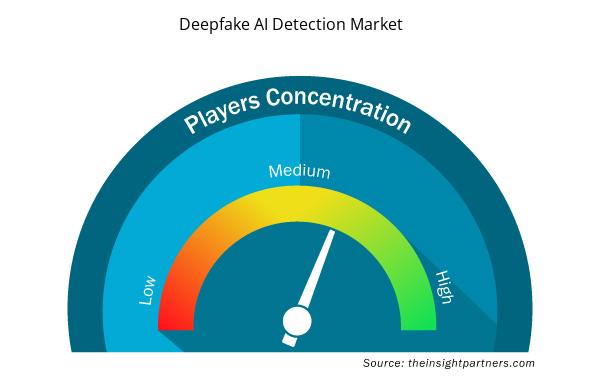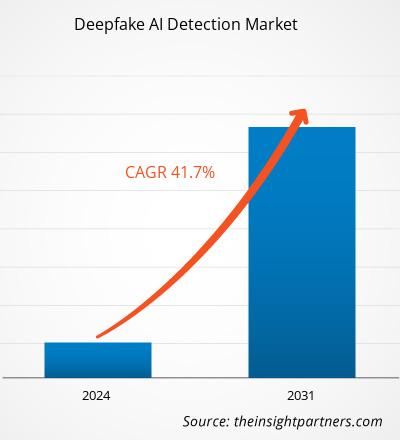ディープフェイクAI検出市場規模は、2023年の2億1,324万米ドルから2031年には34億6,382万米ドルに達すると予想されています。市場は2023年から2031年にかけて41.7%のCAGRを記録すると予測されています。リアルタイムのディープフェイクAI検出ソリューションや、ユーザーの行動要素を取り入れたディープフェイクAI検出の出現により、新たな市場トレンドが生まれる可能性が高くなります。
ディープフェイク AI 検出市場分析
近年、ディープフェイク コンテンツを介したサイバー攻撃の増加により、ディープフェイク AI 検出ソフトウェアの需要が高まっています。ビジネス プロセスは、クラウド、人工知能、高度な自動化システムにますます依存するようになっています。そのため、さまざまな分野での人工知能の利用の増加が、ディープフェイク AI 検出市場を牽引しています。さらに、ディープフェイク AI 検出ソフトウェアは、ディープフェイク コンテンツの検出に関するより優れた洞察を提供し、それに関連する詐欺を認識するのに役立ちます。さらに、モバイル デバイスの普及の増加、メディアおよびエンターテイメント業界の成長、世界中のソーシャル コンテンツの増加は、市場の成長に貢献するその他のいくつかの重要な要因です。
ディープフェイク AI 検出市場の概要
ディープフェイクは、説得力のある偽の画像、音声、動画を作成できる人工知能の一種です。「ディープフェイク」という用語は、ディープラーニングの概念と偽物を組み合わせたものです。ディープフェイクは、偽の画像と音声をコンパイルし、機械学習アルゴリズムを使用してそれらをつなぎ合わせます。これにより、存在しない、または実際には起こらなかった人物やイベントが作成されます。ディープフェイク技術は、主に、偽の情報やプロパガンダを広めて大衆を誤解させるなど、犯罪目的で使用されます。検出技術は、偽造メディアを元の改変されていないメディアと比較することなく識別することを目的としています。これらの高度な技術は通常、機械学習と呼ばれる AI 形式を使用します。モデルは、既知の本物と偽物のメディアのデータでトレーニングされます。方法には、顔認識、ディープフェイク作成の証拠、色の異常の検索が含まれます。
要件に合わせてレポートをカスタマイズする
このレポートの一部、国レベルの分析、Excelデータパックなど、あらゆるレポートを無料でカスタマイズできます。また、スタートアップや大学向けのお得なオファーや割引もご利用いただけます。
- このレポートの主要な市場動向を入手してください。この無料サンプルには、市場動向から見積もりや予測に至るまでのデータ分析が含まれます。
ディープフェイク AI 検出市場の推進要因と機会
ディープフェイク詐欺と詐欺の増加
ディープフェイクAIは、良い面でも悪い面でも使用できます。悪質な行為者や詐欺師によるディープフェイクAIの主な利用方法としては、選挙妨害、恐喝、いじめ、嫌がらせ、フェイクニュース、金融詐欺などがあります。ディープフェイク詐欺の急増は、世界中の人々や企業を襲っています。たとえば、Onfidoの2023年個人情報詐欺レポートによると、個人情報詐欺攻撃では、2022年から2023年にかけてディープフェイク詐欺が31倍に増加しています。さらに、Sum and Substance Ltd.の個人情報詐欺レポート(2023年)によると、個人情報詐欺の割合は2021年の1.1%から2023年には2.0%に増加しています。アジア太平洋地域では、ディープフェイク攻撃が2022年から2023年にかけて1530%増加し、ベトナム、フィリピン、日本がトップを占めています。
北米は、2022年から2023年にかけてディープフェイクが1740%増加し、全業界で世界的に最も多くのディープフェイク攻撃が検出されました。Sum and Substance Ltdのレポートによると、ソーシャルメディア、専門サービス、ヘルスケア、デジタル輸送、ビデオゲームは、2023年に個人情報詐欺やディープフェイク攻撃の影響を最も受けた上位5つの業界です。ディープフェイクは、ディープフェイクコンテンツ、動画、画像など、さまざまな方法で人々に影響を与える可能性があります。Regulaの2024年の調査データによると、ビデオディープフェイクの蔓延が大幅に増加しており、インシデントを報告する企業は2022年と比較して20%増加しています。オーストラリア、フランス、ドイツ、メキシコ、トルコ、UAE、英国、米国の詐欺決定者の約29%が、2022年にビデオディープフェイク詐欺に遭遇したと報告しています。
技術の進歩
ディープフェイクの数が増えるにつれて、フェイク動画や音声の有害な影響から保護するために、ディープフェイク検出ソフトウェアの人気が高まっています。研究者は、色の異常を検出する AI モデルなど、ディープフェイクを検出するための新しい方法を開発しています。最近の研究によると、既存の検出方法とモデルでは、実際のシナリオでディープフェイクを正確に識別できない可能性があります。たとえば、照明条件、顔の表情、またはビデオやオーディオの品質が認識モデルのトレーニングに使用されたデータと異なる場合、またはディープフェイクがトレーニングデータで使用された方法以外の方法で作成された場合、精度が低下する可能性があります。さらに、ディープフェイク生成の将来の進歩により、高度な機械学習、マルチモーダルアプローチなど、異常な目の瞬きなどの現在のディープフェイクの特徴が排除されると予想されます。したがって、ディープフェイク AI 検出ツールの技術的進歩と、高度なディープフェイク AI 検出技術の開発への投資の増加は、2023 年から 2031 年にかけて市場で活動する主要企業に機会を生み出すと予想されます。
ディープフェイク AI 検出市場レポートのセグメンテーション分析
ディープフェイク AI 検出市場分析の導出に貢献した主要なセグメントは、コンポーネント、展開、企業規模、および垂直です。
- コンポーネントに基づいて、世界のディープフェイク AI 検出市場はソフトウェアとサービスに分類されます。2023 年にはソフトウェア セグメントが市場を支配しました。
- 展開に基づいて、世界のディープフェイク AI 検出市場はオンプレミスとクラウドに分類されます。2023 年にはクラウド セグメントが市場を支配しました。
- 企業規模に基づいて、世界のディープフェイク AI 検出市場は中小企業 (SME) と大企業に分類されます。2023 年には大企業セグメントが市場を支配しました。
- 業界別に見ると、ディープフェイク AI 検出市場は、BFSI、メディアとエンターテインメント、政府と政治、ヘルスケアとライフサイエンス、IT と通信、小売と電子商取引、その他に分かれています。2023 年には、メディアとエンターテインメントのセグメントが市場を支配しました。
ディープフェイク AI 検出市場シェアの地域別分析
- ディープフェイク AI 検出市場は、北米、ヨーロッパ、アジア太平洋 (APAC)、中東およびアフリカ (MEA)、南米および中米の 5 つの主要地域に分かれています。2023 年には北米が市場を支配し、ヨーロッパと APAC がそれに続きました。
- 北米では、さまざまな業界でディープフェイクAI検出の進歩と採用に注力している主要企業の存在により、市場で驚異的な成長が見られます。米国やカナダなどの先進国では、インフラが整備されているため、製造企業は科学、技術、商取引の限界を探求することができます。北米には、IBM Corporation、Oracle、BMC Software、Inc.、ServiceNow Inc.、Broadcomなどの主要な市場プレーヤーが存在します。この地域では、2021年から2023年にかけて、すべての主要セクターで機械学習、人工知能、ロボット工学、自動化、デジタル化、ブロックチェーンなどの技術が大量に採用されています。コンテンツ作成のためにさまざまな業界でAIが採用されているため、AIを使用して生成されるディープフェイク攻撃が増加しており、この地域では2022年から2023年にかけて1700%以上増加しています。この地域でのディープフェイク詐欺の増加は、今後数年間でディープフェイクAI検出市場の成長を促進すると予想されます。
ディープフェイク AI 検出市場の地域別分析
予測期間を通じてディープフェイク AI 検出市場に影響を与える地域的な傾向と要因は、Insight Partners のアナリストによって徹底的に説明されています。このセクションでは、北米、ヨーロッパ、アジア太平洋、中東およびアフリカ、南米および中米にわたるディープフェイク AI 検出市場のセグメントと地域についても説明します。

- ディープフェイクAI検出市場の地域別データを入手
ディープフェイクAI検出市場レポートの範囲
| レポート属性 | 詳細 |
|---|---|
| 2023年の市場規模 | 2億1,324万米ドル |
| 2031年までの市場規模 | 34億6,382万米ドル |
| 世界のCAGR(2023年~2031年) | 41.7% |
| 履歴データ | 2021-2022 |
| 予測期間 | 2024-2031 |
| 対象セグメント | コンポーネント別
|
| 対象地域と国 | 北米
|
| 市場リーダーと主要企業プロフィール |
|
ディープフェイク AI 検出市場のプレーヤー密度: ビジネス ダイナミクスへの影響を理解する
ディープフェイク AI 検出市場は、消費者の嗜好の変化、技術の進歩、製品の利点に対する認識の高まりなどの要因により、エンドユーザーの需要が高まり、急速に成長しています。需要が高まるにつれて、企業は提供を拡大し、消費者のニーズを満たすために革新し、新たなトレンドを活用し、市場の成長をさらに促進しています。
市場プレーヤー密度とは、特定の市場または業界内で活動している企業または会社の分布を指します。これは、特定の市場スペースに、その規模または総市場価値と比較して、どれだけの競合相手 (市場プレーヤー) が存在するかを示します。
ディープフェイク AI 検出市場で活動している主要企業は次のとおりです。
- サイトエンジン
- 明瞭性
- フェイスオンライブ
- バスター・アイ
- スプーフィングセンス
- フェイシア
免責事項:上記の企業は、特定の順序でランク付けされていません。

- ディープフェイクAI検出市場のトップキープレーヤーの概要を入手
ディープフェイク AI 検出市場のニュースと最近の動向
ディープフェイク AI 検出市場は、重要な企業出版物、関連データ、データベースを含む一次調査と二次調査後の定性的および定量的データを収集することによって評価されます。ディープフェイク AI 検出市場の動向のいくつかを以下に示します。
- マイクロソフトとOpenAIは、AIとディープフェイクが有権者を欺き民主主義を損なうために利用されるリスクの高まりに対抗するため、200万ドルの資金提供を発表した。
(出典: Microsoft、プレスリリース、2024 年 5 月)
- 生体認証ソリューションの大手プロバイダーである BioID は、更新されたディープフェイク検出テクノロジー 2.0 のリリースを発表しました。このソリューションは、人工知能 (AI) の力を活用して、オンライン プラットフォーム上のディープフェイク メディアなど、操作された画像や動画によってもたらされる最新のサイバーセキュリティの脅威に対抗します。
(出典:BioID、プレスリリース、2024年3月)
ディープフェイク AI 検出市場レポートのカバレッジと成果物
「ディープフェイク AI 検出市場規模と予測 (2021 ~ 2031 年)」では、以下の分野をカバーする市場の詳細な分析を提供します。
- ディープフェイクAI検出市場規模と予測(対象範囲に含まれるすべての主要市場セグメントの世界、地域、国レベル)
- ディープフェイクAI検出市場の動向、および推進要因、制約、主要な機会などの市場動向
- 詳細なPESTおよびSWOT分析
- 主要な市場動向、世界および地域の枠組み、主要プレーヤー、規制、最近の市場動向を網羅したディープフェイクAI検出市場分析
- ディープフェイクAI検出市場の市場集中度、ヒートマップ分析、主要プレーヤー、最近の動向を網羅した業界展望と競争分析
- 詳細な企業プロフィール
- 過去2年間の分析、基準年、CAGRによる予測(7年間)
- PEST分析とSWOT分析
- 市場規模価値/数量 - 世界、地域、国
- 業界と競争環境
- Excel データセット



Report Coverage
Revenue forecast, Company Analysis, Industry landscape, Growth factors, and Trends

Segment Covered
This text is related
to segments covered.

Regional Scope
North America, Europe, Asia Pacific, Middle East & Africa, South & Central America

Country Scope
This text is related
to country scope.
よくある質問
The deepfake AI detection market was estimated to be US$ 213.24 million in 2023 and is expected to grow at a CAGR of 41.7 % during the forecast period 2023 – 2031.
Increasing number of deepfake frauds and scams, increased use of ai in media and entertainment, and stringent government regulations are the major factors that propel the deepfake AI detection market.
Emergence of real-time deepfake ai detection solutions and deepfake ai detection with user behavioral elements, which is anticipated to play a significant role in the deepfake AI detection market in the coming years.
The incremental growth expected to be recorded for the deepfake AI detection market during the forecast period is US$ 3,250.61 million.
The deepfake AI detection market is expected to reach US$ 3463.85 million by 2031.
The key players holding majority shares in the deepfake AI detection market are Sightengine, Clarity, FaceOnLive, Buster.Ai, SpoofSense, Facia.ai, Kroop AI, Reality Defender Inc., Au10tix, Microsoft, BioID, Sensity B.V., ValidSoft, Sentinel, HyperVerge Inc., DuckDuckGoose, McAfee Corp, deepfakedetector.ai, Attestiv Inc., and Intel Corporation.
Trends and growth analysis reports related to Technology, Media and Telecommunications : READ MORE..
The List of Companies - Deepfake AI Detection Market
- Sightengine
- Clarity
- FaceOnLive
- Buster.Ai
- SpoofSense
- Facia.ai
- Kroop AI
- Reality Defender Inc.
- Au10tix
- Microsoft
- BioID
- Sensity B.V.
- ValidSoft
- Sentinel
- HyperVerge Inc.
- DuckDuckGoose
- McAfee Corp
- deepfakedetector.ai
- Attestiv Inc.
- Intel Corporation
The Insight Partners performs research in 4 major stages: Data Collection & Secondary Research, Primary Research, Data Analysis and Data Triangulation & Final Review.
- Data Collection and Secondary Research:
As a market research and consulting firm operating from a decade, we have published and advised several client across the globe. First step for any study will start with an assessment of currently available data and insights from existing reports. Further, historical and current market information is collected from Investor Presentations, Annual Reports, SEC Filings, etc., and other information related to company’s performance and market positioning are gathered from Paid Databases (Factiva, Hoovers, and Reuters) and various other publications available in public domain.
Several associations trade associates, technical forums, institutes, societies and organization are accessed to gain technical as well as market related insights through their publications such as research papers, blogs and press releases related to the studies are referred to get cues about the market. Further, white papers, journals, magazines, and other news articles published in last 3 years are scrutinized and analyzed to understand the current market trends.
- Primary Research:
The primarily interview analysis comprise of data obtained from industry participants interview and answers to survey questions gathered by in-house primary team.
For primary research, interviews are conducted with industry experts/CEOs/Marketing Managers/VPs/Subject Matter Experts from both demand and supply side to get a 360-degree view of the market. The primary team conducts several interviews based on the complexity of the markets to understand the various market trends and dynamics which makes research more credible and precise.
A typical research interview fulfils the following functions:
- Provides first-hand information on the market size, market trends, growth trends, competitive landscape, and outlook
- Validates and strengthens in-house secondary research findings
- Develops the analysis team’s expertise and market understanding
Primary research involves email interactions and telephone interviews for each market, category, segment, and sub-segment across geographies. The participants who typically take part in such a process include, but are not limited to:
- Industry participants: VPs, business development managers, market intelligence managers and national sales managers
- Outside experts: Valuation experts, research analysts and key opinion leaders specializing in the electronics and semiconductor industry.
Below is the breakup of our primary respondents by company, designation, and region:

Once we receive the confirmation from primary research sources or primary respondents, we finalize the base year market estimation and forecast the data as per the macroeconomic and microeconomic factors assessed during data collection.
- Data Analysis:
Once data is validated through both secondary as well as primary respondents, we finalize the market estimations by hypothesis formulation and factor analysis at regional and country level.
- Macro-Economic Factor Analysis:
We analyse macroeconomic indicators such the gross domestic product (GDP), increase in the demand for goods and services across industries, technological advancement, regional economic growth, governmental policies, the influence of COVID-19, PEST analysis, and other aspects. This analysis aids in setting benchmarks for various nations/regions and approximating market splits. Additionally, the general trend of the aforementioned components aid in determining the market's development possibilities.
- Country Level Data:
Various factors that are especially aligned to the country are taken into account to determine the market size for a certain area and country, including the presence of vendors, such as headquarters and offices, the country's GDP, demand patterns, and industry growth. To comprehend the market dynamics for the nation, a number of growth variables, inhibitors, application areas, and current market trends are researched. The aforementioned elements aid in determining the country's overall market's growth potential.
- Company Profile:
The “Table of Contents” is formulated by listing and analyzing more than 25 - 30 companies operating in the market ecosystem across geographies. However, we profile only 10 companies as a standard practice in our syndicate reports. These 10 companies comprise leading, emerging, and regional players. Nonetheless, our analysis is not restricted to the 10 listed companies, we also analyze other companies present in the market to develop a holistic view and understand the prevailing trends. The “Company Profiles” section in the report covers key facts, business description, products & services, financial information, SWOT analysis, and key developments. The financial information presented is extracted from the annual reports and official documents of the publicly listed companies. Upon collecting the information for the sections of respective companies, we verify them via various primary sources and then compile the data in respective company profiles. The company level information helps us in deriving the base number as well as in forecasting the market size.
- Developing Base Number:
Aggregation of sales statistics (2020-2022) and macro-economic factor, and other secondary and primary research insights are utilized to arrive at base number and related market shares for 2022. The data gaps are identified in this step and relevant market data is analyzed, collected from paid primary interviews or databases. On finalizing the base year market size, forecasts are developed on the basis of macro-economic, industry and market growth factors and company level analysis.
- Data Triangulation and Final Review:
The market findings and base year market size calculations are validated from supply as well as demand side. Demand side validations are based on macro-economic factor analysis and benchmarks for respective regions and countries. In case of supply side validations, revenues of major companies are estimated (in case not available) based on industry benchmark, approximate number of employees, product portfolio, and primary interviews revenues are gathered. Further revenue from target product/service segment is assessed to avoid overshooting of market statistics. In case of heavy deviations between supply and demand side values, all thes steps are repeated to achieve synchronization.
We follow an iterative model, wherein we share our research findings with Subject Matter Experts (SME’s) and Key Opinion Leaders (KOLs) until consensus view of the market is not formulated – this model negates any drastic deviation in the opinions of experts. Only validated and universally acceptable research findings are quoted in our reports.
We have important check points that we use to validate our research findings – which we call – data triangulation, where we validate the information, we generate from secondary sources with primary interviews and then we re-validate with our internal data bases and Subject matter experts. This comprehensive model enables us to deliver high quality, reliable data in shortest possible time.


 このレポートの無料サンプルを入手する
このレポートの無料サンプルを入手する